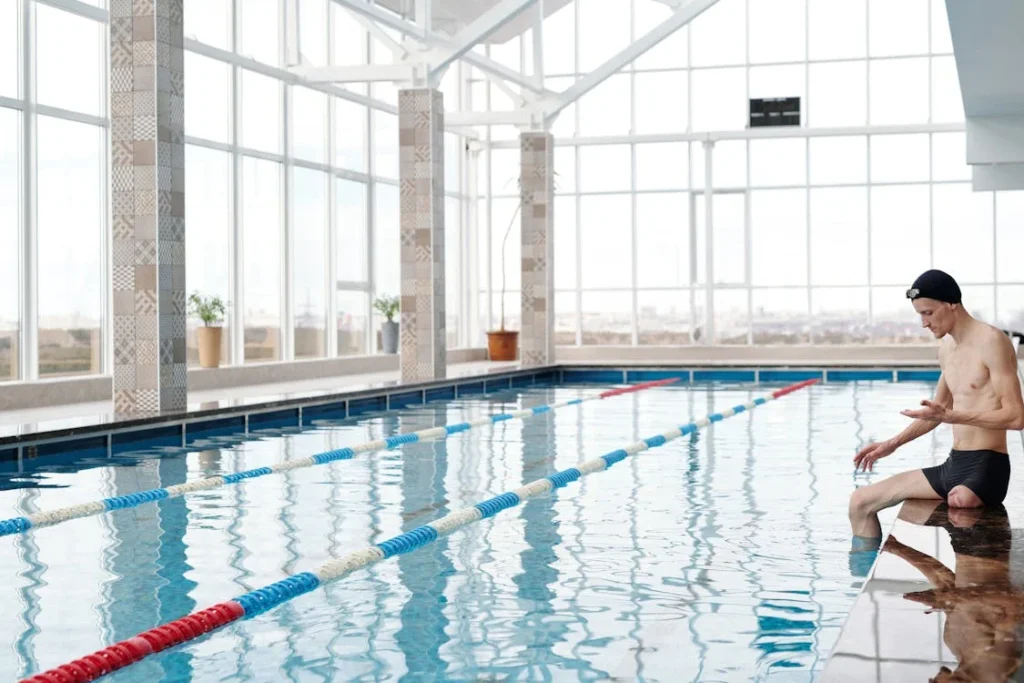Losing a limb is life-changing. It affects your body, your mind, and the way you live every single day. If you’re reading this, either for yourself or someone you care about, you already know this isn’t just a medical event — it’s deeply personal. And it’s okay to feel overwhelmed. It’s okay to feel uncertain, even scared. You’re not alone.
At Robobionics, we’ve walked this journey with many people. We’ve helped them take their first steps again — literally and emotionally. That’s why we’ve written this guide. Not as doctors. Not as machines. But as partners who care deeply about your recovery and your future.
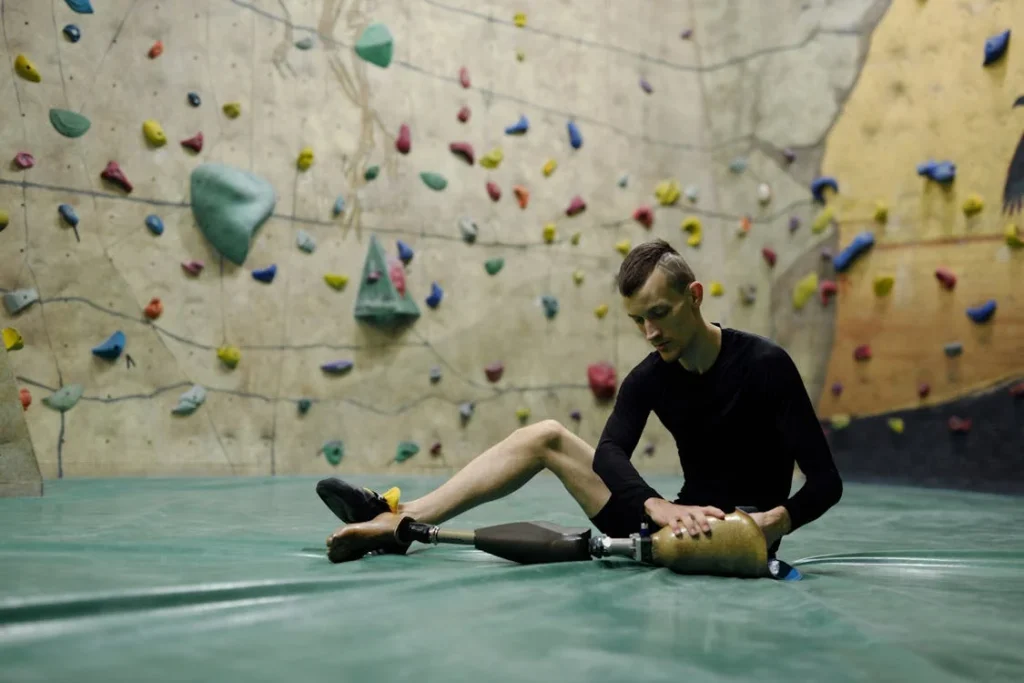
The First Few Days After Surgery
What Happens Right After Amputation?
Once your surgery is over, you’ll wake up in a hospital bed. You may feel tired, groggy, or confused. This is normal — your body has gone through a lot.
Nurses and doctors will be there, checking on you, managing your pain, and making sure your body is stable. You may feel numbness near the area where your limb used to be.
Or, strangely, you might feel as though the limb is still there. This is called phantom limb sensation, and we’ll talk more about it later.
In these first few days, your medical team will focus on two things: keeping you comfortable and preventing complications.
You’ll likely have a bandage or dressing on the site of your amputation. Underneath, there may be stitches or staples. You might also have drains in place to help remove excess fluid from the wound.
You won’t be doing much physically yet. Your main job is to rest. That’s not always easy, especially when your mind is racing or you’re in pain. But rest is one of the most powerful tools your body has right now.
The Emotional Shock
Amputation isn’t just about losing a part of your body. It’s a deep emotional loss, and the shock can be intense. Some people describe it as a wave that crashes over them when they least expect it.
You might cry. You might feel numb. You might feel nothing at all — like you’re watching your life from the outside.
All of this is okay.
Give yourself permission to grieve. What you’re going through is real, and it matters. Try not to compare your reaction to anyone else’s. There is no “right” way to feel.
Family and friends may not know what to say. Some might avoid talking about it, hoping to protect you. Others might try too hard to cheer you up.
This can be frustrating. If you can, let them know what you need — even if what you need is just silence or a hand to hold.
Starting Pain Management
Pain after amputation can take many forms. There’s the obvious physical pain from the surgery itself. This is usually managed with medication, and your doctors will work with you to adjust it as needed.
You’ll also be asked to describe your pain regularly. Don’t be afraid to speak up. You won’t sound like a complainer — your comfort is a medical priority.
Then there’s phantom limb pain — when you feel pain in the limb that’s no longer there. It’s confusing. It can be sharp, burning, tingling, or cramping.
And yes, it’s very real. Scientists are still studying why it happens, but we know this: your brain still remembers the missing limb. It’s like the nerves are sending signals to a place that isn’t there anymore.
There are ways to treat phantom pain, and they don’t always involve pills. Techniques like mirror therapy, massage, and even virtual reality are being used with success. We’ll explore those soon.
You may also have residual limb pain — pain in the part of your limb that remains. This might be due to swelling, pressure from dressings, or nerves healing.
Your doctors will monitor this closely. If the pain gets worse or feels different, tell someone right away.
Learning to Move Again
You won’t be walking out of bed the next morning, but movement will still be part of your recovery — even early on.
Nurses may help you shift positions or sit up slowly. This improves blood flow and helps prevent complications like pneumonia or blood clots.
Physical therapists might start working with you, depending on how your body is responding. They’ll focus on gentle exercises to keep your muscles active and prepare you for the next steps.
It’s not about pushing hard. It’s about laying a safe foundation.
You’ll also begin learning how to care for your surgical site. Nurses will teach you how to keep it clean, watch for infection, and manage dressings.
If you feel nervous, ask questions. Write things down. It’s okay to need reminders. You’re taking in a lot, and nobody expects you to remember everything.
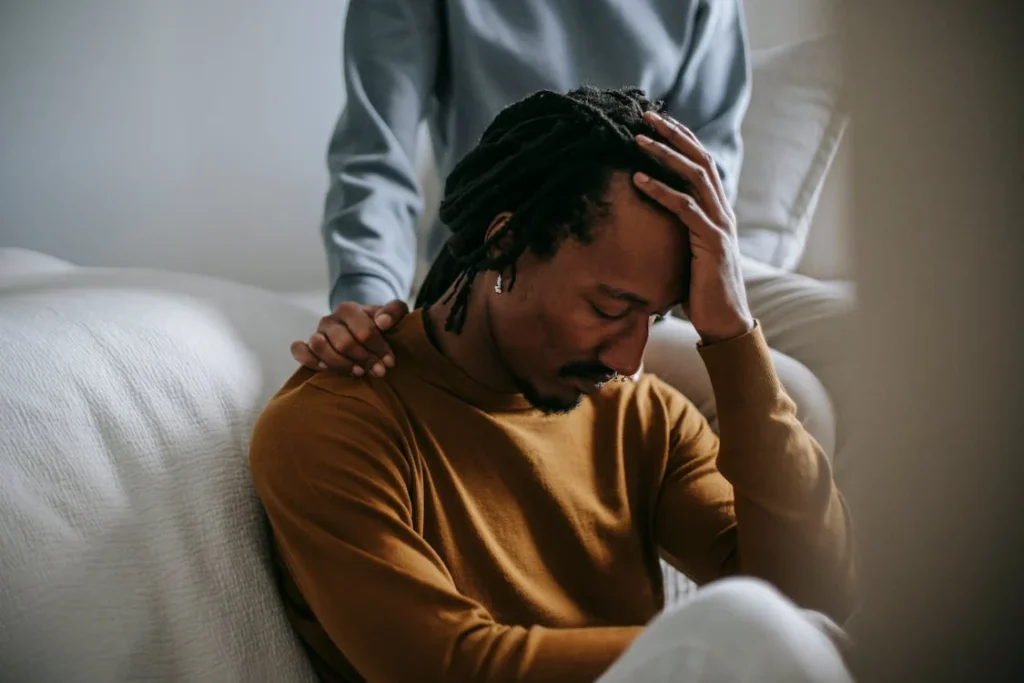
The First Weeks: Managing Pain, Healing, and Adapting
Understanding the Healing Process
Healing after an amputation isn’t just physical — it’s emotional and mental too. But let’s first talk about your body. Over the next few weeks, your surgical site will begin to close up.
The swelling will slowly reduce. You may notice bruising around the area or tenderness that comes and goes. These are all signs that your body is doing its job.
The skin around your amputation will change in appearance. It may feel tight, dry, or even itchy. This is normal. As the wound heals, the nerves inside are also reacting.
Sometimes, they misfire. You might feel shooting pain or strange sensations. While that can be alarming, most of these signs are expected parts of nerve healing.
If something feels extreme or out of place, talk to your doctor. Don’t wait. Your voice matters in this journey.
Staying healthy during healing means staying alert. Watch for signs of infection: redness that spreads, warmth near the wound, foul smell, unusual discharge, or fever.
If you notice any of these, contact your care team right away. Catching infections early makes a big difference.
It’s also important to keep moving. Even if you’re not standing yet, small movements can prevent your muscles from weakening.
Deep breathing, shoulder rolls, gentle stretches — these simple motions keep your body engaged and help your energy return.
The Role of Pain Management
By now, your pain levels may have changed. For some, the sharp pain of surgery fades quickly. For others, it lingers.
Pain after amputation is personal — no two people experience it the same way. That’s why your treatment should be personal too.
Doctors may adjust your medications, trying out different combinations. Sometimes opioids are used, but always for a short time.
Other drugs, like nerve blockers or anti-inflammatory medicines, can help without the risks that come with long-term opioid use.
But medication isn’t your only option. Techniques like massage therapy, heat and cold application, and transcutaneous electrical nerve stimulation (TENS) can bring relief without side effects. Some people also respond well to acupuncture, though results vary.
And then there’s mirror therapy — a fascinating technique where a mirror is placed in a way that tricks your brain into “seeing” your missing limb.
Over time, this visual feedback can calm nerve signals and reduce phantom pain. It sounds odd, but it’s helped many people regain comfort.
Talk to your care team about what works for you. You are the expert on your body. Your feedback helps shape the treatment.
Emotional Healing Begins
You may find your emotions changing quickly. Some days you may feel hopeful and strong. Other days, the smallest things might bring tears or frustration.
This is part of the healing too. You’re dealing with something big, and your emotions need space.
Depression and anxiety are common after amputation. You might feel like you’ve lost part of your identity. That’s not weakness. It’s grief. And grief is a process, not a single moment.
Seeing a counselor or therapist can help. These professionals aren’t just for “mental illness.” They’re here to walk beside you, to listen, to help you make sense of things.
If talking feels hard, there are also support groups — both in person and online — where others share similar stories. Just knowing someone else “gets it” can be powerful.
It’s also okay to feel angry or impatient. Healing takes time, and some parts of it are slow. Be kind to yourself. Celebrate small wins. Getting out of bed. Taking a shower. Sleeping better. Every step forward matters.
Your Support System
This is not something you should go through alone. Friends, family, nurses, doctors, therapists — all of them are part of your support system. Let them in. Let them help.
Sometimes loved ones want to help but don’t know how. You can guide them. Tell them when you need company.
Tell them when you need space. Let them know what makes your day easier. This communication creates stronger bonds and helps everyone heal together.
If you don’t have many people around, ask your hospital or clinic about social services. There are organizations and volunteers who are ready to support you.
You’re not forgotten. You’re not invisible. Help is out there, and you deserve to receive it.
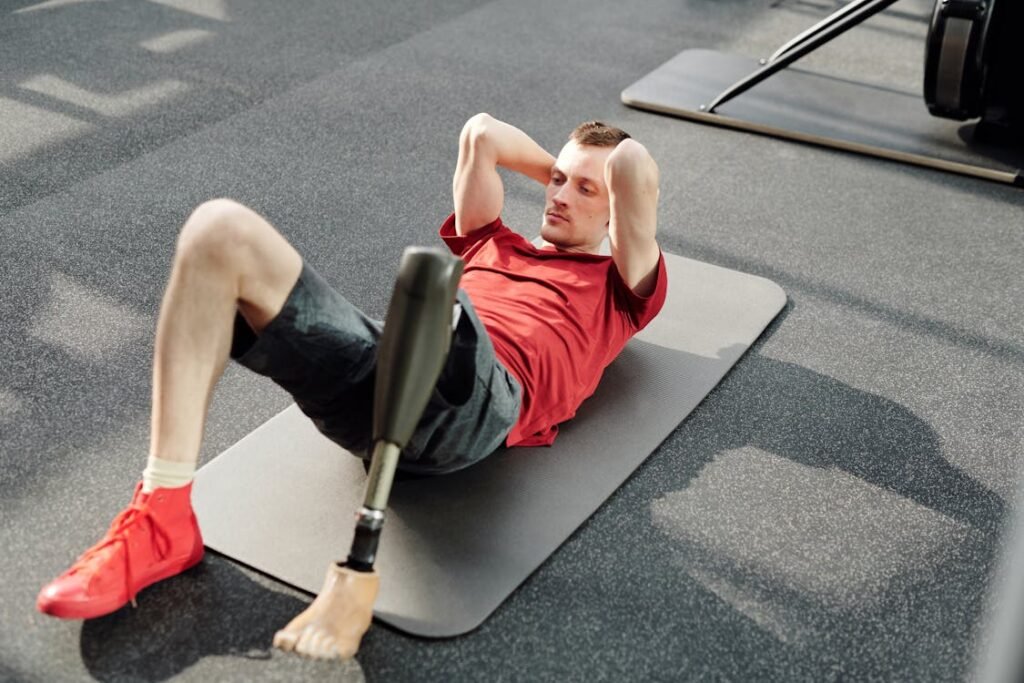
Regaining Independence: Building Your New Routine
Preparing for Prosthetic Use
As your body heals and the swelling goes down, your doctors and rehab team will begin talking to you about a prosthetic limb.
This doesn’t happen overnight. You need to be fully healed and strong enough before you start that process. But early preparation makes a big difference.
First, your residual limb (also called the “stump”) will need to be shaped and strengthened. This is often done with compression garments or special wraps that help reduce swelling and mold the limb into a good shape for fitting a prosthetic.
You may feel discomfort at first — that’s expected. It takes time for the skin and muscles to adapt.
During this phase, you’ll work closely with a physical therapist or occupational therapist. These specialists will teach you how to build strength in the rest of your body, especially the muscles that will support the prosthetic limb.
For example, if you’ve lost a leg, your hips and core need to be strong. If it’s an arm, you’ll work on shoulder and back strength. These exercises don’t just prepare you physically — they also help you feel more confident.
When the time is right, your prosthetist will enter the picture. This is the expert who designs and fits your artificial limb. At Robobionics, we work hard to make sure every prosthetic is a perfect fit — not just in size, but in lifestyle.
A prosthetic for someone who wants to walk their dog every morning is different from one for someone who wants to run or lift weights. Your goals matter.
The fitting process will involve several appointments. You’ll try on test sockets and give feedback. Is it too tight? Too loose? Does it rub anywhere? Don’t rush. Comfort is key. A poorly fitted prosthetic can cause more pain than it solves.
Once your prosthetic is ready, you’ll begin training. Walking or using your arm again won’t feel natural at first. It takes patience, repetition, and support.
You might feel frustrated some days. That’s normal. But every step you take brings you closer to independence.
Facing Daily Tasks with Confidence
Simple things like brushing your teeth, making tea, or getting dressed can suddenly feel like challenges. But they don’t have to stay that way.
Your rehab team will help you find new ways to do old tasks — and surprisingly, many of these new ways end up being just as fast and efficient.
You may be introduced to adaptive tools. These are specially designed items that make daily life easier — like one-handed can openers, shower chairs, or grabber tools for picking things up from the floor.
Using these doesn’t mean you’re weak. It means you’re smart. You’re finding what works for you.
At home, you might need to make a few changes too. If you’ve had a leg amputation, for example, rearranging furniture so there are clear paths can help prevent falls.
Adding handrails near stairs or in the bathroom gives extra safety. If stairs are too hard at first, setting up a bedroom space on the ground floor may be helpful.
Cooking, cleaning, even typing — all of these are things you can get back to. The key is to take your time and ask for help when needed.
Your abilities haven’t disappeared — they’ve just changed shape. And with practice, they’ll feel second nature again.
Returning to Work or School
Going back to your job or your studies might feel far away at first. But it’s possible — and many people do it. You may need to take it step by step.
Maybe you start with part-time hours, or work from home. If you’re a student, talk to your school about accommodations — extra time, a modified desk, or help getting around campus.
Let your employer or school know what’s happening. They may not fully understand amputation, but most will be willing to help if you’re open with them.
You don’t have to share everything — just what you’re comfortable with. And remember, returning to your daily life isn’t just about income or grades. It’s about getting your rhythm back. Your purpose. Your social life.
Even if your old job no longer suits your needs, this could be a time to explore something new. We’ve seen many people start businesses, go back to school, or change careers entirely after amputation.
Sometimes a new chapter begins not in spite of what you’ve been through — but because of it.
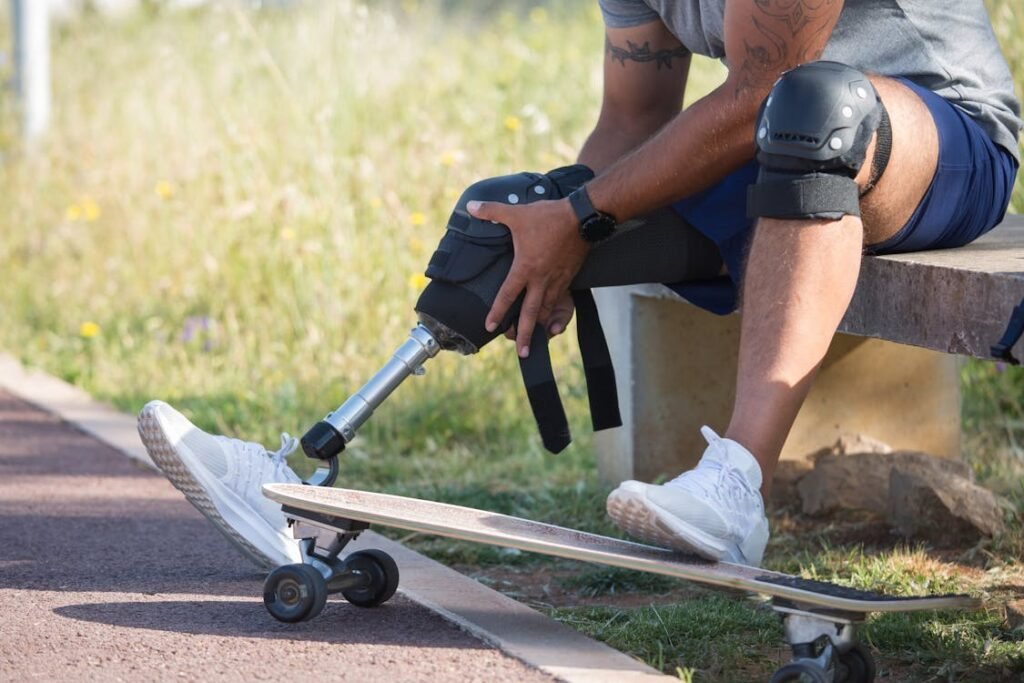
Coping With Phantom Limb Sensations and Long-Term Pain
Understanding Phantom Limb Sensations
One of the most puzzling things after an amputation is when you feel like your missing limb is still there. This is called phantom limb sensation. It can feel like tingling, pressure, itching, or even movement.
And while it might seem strange, it’s incredibly common. Almost everyone who has an amputation experiences it to some degree.
Your brain and nervous system still remember the missing limb. The nerves that once connected to that part of your body are still active.
They’re sending signals, but there’s no longer a limb to receive them. It’s like calling a number that’s no longer in service — the signal goes out, but it doesn’t land anywhere. Still, the brain keeps trying.
These sensations can come and go. Sometimes they fade with time. Sometimes they stay. The key is learning how to manage them — not to fight them, but to understand what your body is saying.
What Phantom Pain Feels Like
Not all phantom sensations are painful. But when they are, it becomes phantom limb pain — and that’s something many people find tough to deal with.
It might feel like burning, stabbing, twisting, or cramping in the limb that’s no longer there. The pain might be constant or come in sudden jolts.
This pain is very real. It’s not “in your head.” It’s in your nervous system. And while that makes it complicated, it also means there are many ways to treat it.
Your care team might try different medications, including those for nerve pain, like gabapentin or amitriptyline.
Some people find relief through mirror therapy, where you place a mirror between your legs or arms and move the existing limb while watching its reflection. Your brain “sees” both limbs and can begin to rewire itself.
Other helpful options include virtual reality, hypnotherapy, relaxation techniques, and biofeedback — where you learn to control how your body responds to pain.
Even guided imagery (where you mentally visualize your limb and give it comfort) has been shown to help some people manage phantom pain.
There’s no single cure, and it can take time to find what works for you. But don’t give up. Your pain is manageable — and your comfort is worth pursuing.
Long-Term Pain Management
Even after the initial healing is done, you might still have some pain in the remaining part of your limb. This is called residual limb pain.
It can happen for many reasons — skin irritation, pressure from your prosthetic, or even tiny nerve endings called neuromas that become inflamed.
It’s important to talk to your prosthetist regularly. A small adjustment in your socket or padding can make a big difference. In some cases, surgery may be needed to remove painful neuromas or reshape the bone.
Stretching, massage, and desensitization therapy (which involves gently rubbing or tapping the limb with different textures) can also help.
These methods teach your nerves to calm down and stop overreacting to touch or movement.
If your pain gets worse or changes suddenly, don’t ignore it. Chronic pain can affect your mood, sleep, and relationships.
Let your doctor know, even if it feels like a “small thing.” You deserve to live without constant discomfort.
Also, consider keeping a pain diary. Write down when the pain starts, what it feels like, how long it lasts, and what you were doing at the time. This can help your medical team spot patterns and tailor your treatment better.
Your Body, Your Pace
As the weeks and months pass, you’ll learn more about how your body responds. Some days you’ll feel strong. Other days, tired. Some mornings you’ll wake up pain-free. Others, you might need to take it slow.
This is all part of the process. Healing isn’t a straight line. There will be setbacks — and that’s okay. What matters most is that you keep showing up for yourself.
Don’t be hard on your body for feeling pain. It’s not a failure. It’s your body’s way of asking for care. And every time you listen, every time you respond with patience, you move closer to peace.

Emotional Recovery and Mental Health After Amputation
The Emotional Weight of Amputation
Losing a limb changes more than just your ability to move — it affects how you see yourself, how others see you, and how you relate to the world.
Even if you were prepared for the surgery, the emotional impact can be deep and unpredictable.
You may feel a mix of emotions — sadness, frustration, fear, anger, guilt. Sometimes these emotions come all at once. Other times, they appear when you least expect them.
Maybe you break down while trying to tie your shoes. Or you get overwhelmed by a simple task that now feels impossible. These moments are painful, but they’re also normal. They don’t make you weak. They make you human.
Grieving the loss of your limb is real. It’s not dramatic or over-the-top. Just like someone mourns the death of a loved one, you may mourn the part of your body you lost.
You’re also mourning the life you had before — the freedom, the ease, the confidence.
But mourning is not the end of the story. It’s the beginning of healing.
Depression and Anxiety: Spotting the Signs
After amputation, it’s common to feel down or anxious. But when those feelings stick around and start to affect your daily life, it could be something more.
You might notice you’re sleeping too much — or not at all. Maybe you’ve lost interest in things you once enjoyed. You feel numb, like you’re just going through the motions. Or you find yourself thinking, “What’s the point?”
These can be signs of depression.
Or maybe your mind is always racing. You’re constantly worried — about your health, your future, your finances. You find it hard to relax or breathe deeply. These might be signs of anxiety.
Both are common. And both are treatable.
You don’t have to figure it out alone. Talk to a therapist, a counselor, or even your family doctor. Just opening up about how you feel can bring relief.
And there’s no shame in needing help. In fact, reaching out is one of the strongest things you can do.
Medication, talk therapy, or a mix of both can make a big difference. So can simple habits like walking outside, journaling, listening to music, or spending time with loved ones. Mental health isn’t a switch you flip — it’s a muscle you strengthen.
The Power of Talking
There’s something powerful about hearing someone say, “I’ve been through this too.” Whether it’s in a group, online, or one-on-one, sharing your experience helps you feel less alone.
Support groups — whether in person or virtual — connect you with others who understand what you’re going through.
You can trade tips, vent frustrations, or just listen. Sometimes, just knowing others have made it through the same storm can give you hope.
If groups aren’t your thing, even a single conversation with someone who’s been through amputation can make a world of difference. Ask your hospital or prosthetics provider if they can connect you with a peer mentor.
And don’t forget your own story. You don’t have to share it with the world, but keeping a personal journal can help you understand your journey. It gives you space to process your emotions and track your growth.
Rebuilding Self-Image and Confidence
One of the hardest things after amputation is looking in the mirror. Your body has changed. And that can be jarring, painful, or even scary. You might feel like a stranger to yourself.
It’s okay to feel that way. But it won’t last forever.
Over time, you’ll learn to see yourself differently — not as broken, but as resilient. Not as someone who lost something, but someone who gained strength through hardship.
Your body might look different, but it’s still yours. And it’s still capable of love, strength, and joy.
Wearing your prosthetic for the first time can be emotional. Some people feel excited, others feel unsure. It might feel like a step toward normalcy. Or it might feel like a reminder of what’s changed. Whatever you feel is valid.
Surround yourself with people who lift you up. Celebrate your progress — no matter how small. The day you walk again. The day you shower without help. The first time you go out in public without hiding.
Confidence doesn’t come all at once. It builds, slowly, through action, support, and self-acceptance.
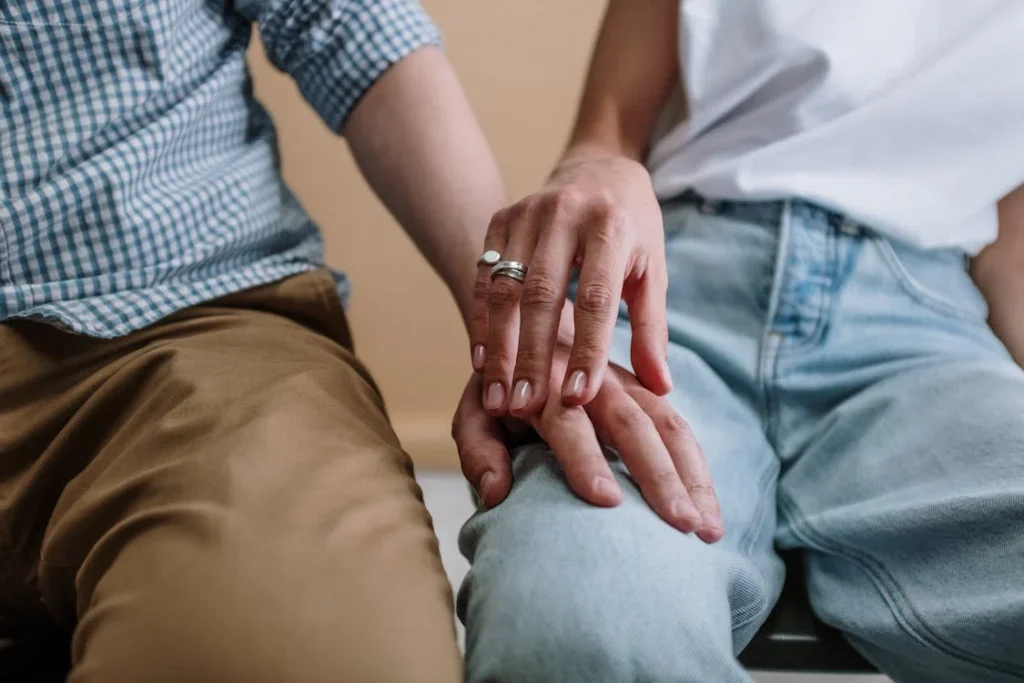
Getting Back to Life: Routines, Relationships, and Rediscovery
Rebuilding Your Daily Routine
Once the initial phase of recovery settles down, a quiet question begins to rise: “Now what?” This is the part where you start building your new normal.
Routines, even simple ones, can bring a sense of structure and calm to your day.
Start small. Wake up at the same time each morning. Make your bed. Drink a glass of water. These are not just chores — they’re anchors. They remind your body and mind that the day has begun, and you have a role to play in it.
As you regain strength, gradually add more to your day. Maybe you begin light exercise, do a few stretches, or walk short distances with your prosthetic.
Even something as simple as watering a plant or making breakfast is a sign that you’re adapting.
Don’t expect your routine to look exactly like it did before. And don’t force yourself to “go back” to everything.
You’re not moving backward — you’re moving forward into a different rhythm. One that fits your body and mind as they are now.
Rest is part of the routine too. Fatigue is common, especially during rehab. Give yourself breaks. Respect your energy levels. Pushing through pain or exhaustion won’t speed things up — it can actually set you back.
Navigating Relationships After Amputation
Relationships change after something as big as an amputation. Not because people stop caring, but because they don’t always know how to show it.
Friends and family might feel helpless or afraid of saying the wrong thing. Some may avoid talking about your limb loss entirely. Others may overcompensate, offering help you didn’t ask for.
These shifts can feel isolating. But most of the time, they’re not about you — they’re about your loved ones adjusting to a new reality too.
Talk to them. Let them know how you’re feeling and what you need. Maybe you want them to treat you exactly the same.
Or maybe you need a little extra emotional support. You might even need space. Whatever it is, the more you communicate, the more they’ll understand how to support you.
If you’re in a romantic relationship, intimacy may also change — not just physically, but emotionally. You might feel insecure about your body, or afraid that your partner sees you differently.
Honest conversations, patience, and a willingness to explore new ways of connecting can help rebuild that bond.
If you’re single, you may wonder how future relationships will go. Will others accept you? Will they look past your amputation? These fears are natural.
But remember — your worth isn’t tied to your number of limbs. The right people will see your strength, not your scars.
Returning to Social Life and Leisure
At some point, you’ll feel the pull to rejoin the world — to go out, meet friends, travel, or simply be part of things again. That step can feel both exciting and scary.
Going out in public for the first time after an amputation may come with anxiety. Will people stare? Will they ask questions? What if something goes wrong?
It helps to plan ahead. Go to places you’re familiar with first. Bring someone you trust. Wear clothes that make you feel good.
Remember, you don’t owe anyone an explanation — but you can share your story if you want to. It’s your choice.
Revisiting old hobbies can also help you reconnect with joy. Whether it’s painting, gardening, gaming, playing music, or reading — returning to things that make you you can remind you that you’re still whole.
And don’t be afraid to try something new. Many people discover new passions after amputation — adaptive sports, volunteering, writing, or even mentoring others going through similar experiences.
Your social life may not look exactly as it did before. But it can still be full, rich, and deeply rewarding.
Travel, Adventure, and Possibility
When you’re ready, travel can be a beautiful way to regain a sense of freedom. It might take extra planning — packing medical supplies, researching accessibility, or checking for prosthetic support services at your destination — but it’s possible.
Start with short trips. Visit a friend. Take a weekend away. Slowly, you’ll build confidence.
There are also growing communities for adaptive adventurers. People hiking, biking, swimming — all with prosthetics or mobility aids.
The world is still open to you. It just takes a little more planning, and a lot more courage — which you already have.
Conclusion
Life after amputation is not the end — it’s a beginning. Yes, it’s hard. It changes everything. But it also reveals strength you didn’t know you had. Every step, every stretch, every small win — it adds up.
You will have hard days. That’s true. But you’ll also have good days. Days where you laugh without guilt. Days where you do something you thought you’d never do again. Healing takes time, patience, and support — but it’s possible.
At Robobionics, we believe your future is not limited by your past. With the right tools, care, and mindset, you can live fully, boldly, and freely. You are more than your limb. You are your courage, your choices, your story.
And your story is still being written — one brave day at a time.



